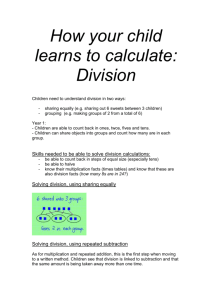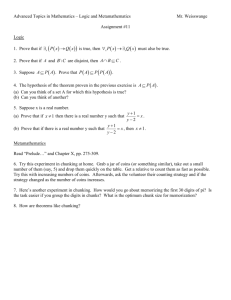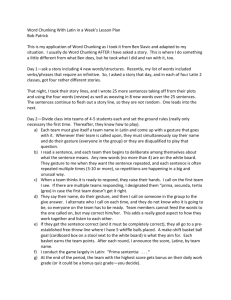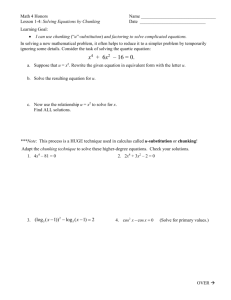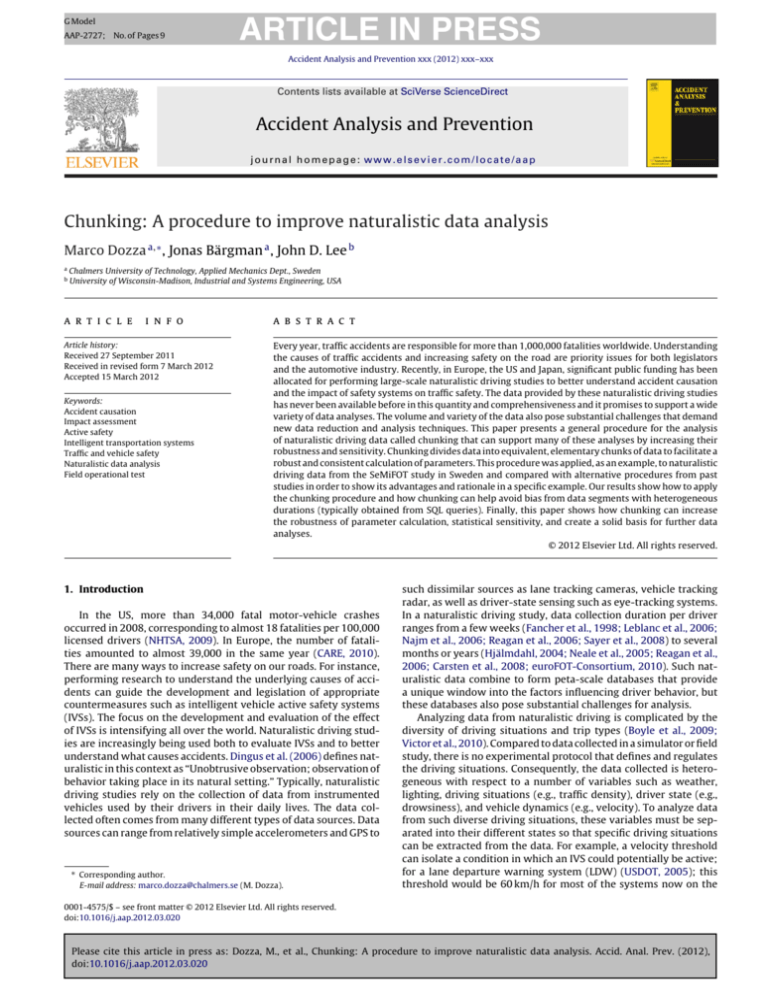
G Model
AAP-2727; No. of Pages 9
ARTICLE IN PRESS
Accident Analysis and Prevention xxx (2012) xxx–xxx
Contents lists available at SciVerse ScienceDirect
Accident Analysis and Prevention
journal homepage: www.elsevier.com/locate/aap
Chunking: A procedure to improve naturalistic data analysis
Marco Dozza a,∗ , Jonas Bärgman a , John D. Lee b
a
b
Chalmers University of Technology, Applied Mechanics Dept., Sweden
University of Wisconsin-Madison, Industrial and Systems Engineering, USA
a r t i c l e
i n f o
Article history:
Received 27 September 2011
Received in revised form 7 March 2012
Accepted 15 March 2012
Keywords:
Accident causation
Impact assessment
Active safety
Intelligent transportation systems
Traffic and vehicle safety
Naturalistic data analysis
Field operational test
a b s t r a c t
Every year, traffic accidents are responsible for more than 1,000,000 fatalities worldwide. Understanding
the causes of traffic accidents and increasing safety on the road are priority issues for both legislators
and the automotive industry. Recently, in Europe, the US and Japan, significant public funding has been
allocated for performing large-scale naturalistic driving studies to better understand accident causation
and the impact of safety systems on traffic safety. The data provided by these naturalistic driving studies
has never been available before in this quantity and comprehensiveness and it promises to support a wide
variety of data analyses. The volume and variety of the data also pose substantial challenges that demand
new data reduction and analysis techniques. This paper presents a general procedure for the analysis
of naturalistic driving data called chunking that can support many of these analyses by increasing their
robustness and sensitivity. Chunking divides data into equivalent, elementary chunks of data to facilitate a
robust and consistent calculation of parameters. This procedure was applied, as an example, to naturalistic
driving data from the SeMiFOT study in Sweden and compared with alternative procedures from past
studies in order to show its advantages and rationale in a specific example. Our results show how to apply
the chunking procedure and how chunking can help avoid bias from data segments with heterogeneous
durations (typically obtained from SQL queries). Finally, this paper shows how chunking can increase
the robustness of parameter calculation, statistical sensitivity, and create a solid basis for further data
analyses.
© 2012 Elsevier Ltd. All rights reserved.
1. Introduction
In the US, more than 34,000 fatal motor-vehicle crashes
occurred in 2008, corresponding to almost 18 fatalities per 100,000
licensed drivers (NHTSA, 2009). In Europe, the number of fatalities amounted to almost 39,000 in the same year (CARE, 2010).
There are many ways to increase safety on our roads. For instance,
performing research to understand the underlying causes of accidents can guide the development and legislation of appropriate
countermeasures such as intelligent vehicle active safety systems
(IVSs). The focus on the development and evaluation of the effect
of IVSs is intensifying all over the world. Naturalistic driving studies are increasingly being used both to evaluate IVSs and to better
understand what causes accidents. Dingus et al. (2006) defines naturalistic in this context as “Unobtrusive observation; observation of
behavior taking place in its natural setting.” Typically, naturalistic
driving studies rely on the collection of data from instrumented
vehicles used by their drivers in their daily lives. The data collected often comes from many different types of data sources. Data
sources can range from relatively simple accelerometers and GPS to
∗ Corresponding author.
E-mail address: marco.dozza@chalmers.se (M. Dozza).
such dissimilar sources as lane tracking cameras, vehicle tracking
radar, as well as driver-state sensing such as eye-tracking systems.
In a naturalistic driving study, data collection duration per driver
ranges from a few weeks (Fancher et al., 1998; Leblanc et al., 2006;
Najm et al., 2006; Reagan et al., 2006; Sayer et al., 2008) to several
months or years (Hjälmdahl, 2004; Neale et al., 2005; Reagan et al.,
2006; Carsten et al., 2008; euroFOT-Consortium, 2010). Such naturalistic data combine to form peta-scale databases that provide
a unique window into the factors influencing driver behavior, but
these databases also pose substantial challenges for analysis.
Analyzing data from naturalistic driving is complicated by the
diversity of driving situations and trip types (Boyle et al., 2009;
Victor et al., 2010). Compared to data collected in a simulator or field
study, there is no experimental protocol that defines and regulates
the driving situations. Consequently, the data collected is heterogeneous with respect to a number of variables such as weather,
lighting, driving situations (e.g., traffic density), driver state (e.g.,
drowsiness), and vehicle dynamics (e.g., velocity). To analyze data
from such diverse driving situations, these variables must be separated into their different states so that specific driving situations
can be extracted from the data. For example, a velocity threshold
can isolate a condition in which an IVS could potentially be active;
for a lane departure warning system (LDW) (USDOT, 2005); this
threshold would be 60 km/h for most of the systems now on the
0001-4575/$ – see front matter © 2012 Elsevier Ltd. All rights reserved.
doi:10.1016/j.aap.2012.03.020
Please cite this article in press as: Dozza, M., et al., Chunking: A procedure to improve naturalistic data analysis. Accid. Anal. Prev. (2012),
doi:10.1016/j.aap.2012.03.020
G Model
AAP-2727; No. of Pages 9
ARTICLE IN PRESS
M. Dozza et al. / Accident Analysis and Prevention xxx (2012) xxx–xxx
2
market. Selection conditions fragment the data into long and short
segments of continuous time, also within a trip. Converting data
fragmented into segments of heterogeneous size and variable states
creates several challenges for data analysis such as the calculation
of robust parameters to describe IVSs performance and assess crash
causation.
Data fragmentation is a prevalent challenge. The European
FESTA project (Festa-Consortium, 2008b) created guidelines for
field operational tests that are currently followed by the major
European field operational tests, such as euroFOT (euroFOTConsortium, 2010) and teleFOT (teleFOT-Consortium, 2010). These
guidelines list parameters (called performance indicators) for field
operational test use (Festa-Consortium, 2008a). Approximately one
third of the objective safety-related parameters proposed by FESTA
are vulnerable to problems posed by data fragmentation.
The current analyses of naturalistic data have avoided substantial errors that fragmentation can cause. One reason for this success
is that only a few experts have analyzed data from naturalistic studies because data access has been very restricted. In most analyses,
data fragmentation and resultant issues were handled appropriately, or parameters that were robust with respect to fragmentation
were used. Naturalistic data analyses and the number of analysts
will grow significantly over the next few years, chiefly through the
US Strategic Highway Research Program 2 (SHRP2, 2010), which
will make naturalistic data available to many researchers. For
this reason, it is important that methods that enhance comparability and robustness of naturalistic data analysis are developed
and adopted soon. This paper presents a procedure that facilitates
the calculation of robust parameters extracted from continuous
naturalistic data. Such data procedure facilitates the analysis of naturalistic data, which is intrinsically diverse (e.g., in terms of trip
durations, driving situations, and driver behavior).
This paper discusses fragmentation, which is intrinsic to naturalistic data analysis; the paper also presents a procedure for the
analysis of fragmented data from quasi-experimental studies such
as naturalistic driving studies. The procedure is called chunking
and, in this paper, it was applied to one specific step in hypothesis testing (i.e., calculation of parameters in treatment conditions)
to show how to apply the method when testing hypotheses. We
believe that this procedure can support the development of robust
and comparable methods for parameter calculations on naturalistic data. Also, this procedure can help new naturalistic data users
to avoid biases due to fragmentation from basic SQL queries that
may lead to improperly calculated parameters.
2. Methods
2.1. Data
A total of approximately 1142 h of naturalistic driving were
collected from the Swedish national field operational test methodology project SeMiFOT (Victor et al., 2010). The data were collected
from 14 drivers aged 45.5 ± 9.2 years (mean and SD), who had held
driver licenses for 27.4 ± 9.2 years (mean and SD). Fifty percent of
the drivers were women and fifty percent men. The data were collected over a period of approximately six months, primarily in the
region of Västra Götaland, Sweden. In 49% of the 1142 h, velocity was below 50 km/h, in 16% between 50 and 70 km/h, in 18%
between 70 and 90 km/h, and in 17% above 90 km/h. The thresholds
50, 70, and 90 km/h are standard speed limits on Swedish roads.
Seven Volvo Car Corporation leased vehicles were used by study
participants as private cars in their everyday driving. A total of
approximately 270 signals from different data sources were collected continuously from each vehicle. The data sources included
GPS, vehicle controller area network (CAN) bus (ISO, 2003) video,
and accelerometers, as well as eye tracker and extra lane tracker.
Data was collected on a per trip basis, i.e. from engine start to engine
stop. After data was collected on hard drives inside the vehicles, it
was transferred to SAFER (SAFER, 2010) for processing and database
upload. Prior to uploading the data onto an OracleTM SQL database,
it was synchronized and re-sampled from its original frequency to
10 Hz. Analysis was performed using SQL queries combined with
MatlabTM .
2.2. Analysis procedures
In this paper, the two signals velocity and lane offset from the
vehicle CAN bus were extracted from the database and analyzed following the procedures in Fig. 1. These signals were chosen because
they relate to longitudinal control (speed selection and maintenance) and lateral control (lane keeping and curve negotiation) and
are thus central for safety analysis. Specifically, lane offset is a signal used by Lane Departure Warnings (LDW). Velocity is a typical
selection factor for naturalistic driving data because it can be used
as a surrogate measure for road type, traffic density (in relation to
posted speed limits), and safety (Nilsson, 2004; Cameron and Elvik,
2008; Turner-Fairbank Highway Research Center, 2010). Typical
parameters, calculated using velocity and lane offset for naturalistic
driving studies, are mean velocity (MV; (Hjälmdahl, 2004; Leblanc
et al., 2006; Najm et al., 2006; Reagan et al., 2006; Carsten et al.,
2008; Sayer et al., 2008) and standard deviation of lane position
(SDLP; Orban et al., 2006; Alkim et al., 2007; Festa-Consortium,
2008a), respectively. These parameters have been used to evaluate longitudinal and lateral control and often serve as safety
indicators. In this paper the term parameter refers to an indicator, calculated from naturalistic driving signals that is used for data
analysis and, more specifically, for hypothesis testing. However, the
results presented in this paper extend, as it will be clarified in the
discussion, to other parameters such as those presented in FESTA
(Festa-Consortium, 2008a).
This paper also refers to segments as intervals of continuous data
that fulfill a specific criterion for data extraction such as an SQL
query. More specifically, each trip in this study was divided into
segments of time-continuous data (10-Hz sample rate) in which
velocity was above 70 km/h (velocity threshold criterion from our
SQL query). Each segment starts from the first occurrence of a sample above 70 km/h and ends when it falls below 70 km/h again (as
shown in Fig. 2). Our selection criterion can be expressed with the
following pseudo SQL query: SELECT velocity AND LaneOffset FROM
All Trips WHERE velocity >70 km/h. After running this query, segments are individuated by finding sections of continuous (10 Hz)
data. The threshold of 70 km/h was chosen because it was compatible with IVSs activation thresholds, and would thus be a valid
condition in the evaluation of such a system in a field operational
test. Furthermore, in Sweden 70 km/h is also the posted speed limit
that divides urban and rural roads. The segments individuated in
the process described above may have a length from a single sample
(0.1 s) up to an entire trip that might last several hours (minus the
time for accelerating to above 70 km/h and decelerating to 0 km/h).
The number of segments in each trip may vary (zero to hundreds)
depending on how long a trip was and how many times the driver
crossed the threshold. Segments are key components in the analysis
presented in this paper (step 1 in Fig. 1a). Instead of segmentation in time, other variables such as velocity or distance can be
used depending on the analysis focus. The sequence of typical steps
for data processing for hypothesis testing for naturalistic data is
then according to Fig. 1: step 1, data fulfilling specific conditions
are extracted using an SQL query, producing segments; step 2, the
parameters are calculated for each of the segments individually,
and step 3, all segments for a condition are merged into combined
parameters.
Please cite this article in press as: Dozza, M., et al., Chunking: A procedure to improve naturalistic data analysis. Accid. Anal. Prev. (2012),
doi:10.1016/j.aap.2012.03.020
G Model
AAP-2727; No. of Pages 9
ARTICLE IN PRESS
M. Dozza et al. / Accident Analysis and Prevention xxx (2012) xxx–xxx
3
Fig. 1. (a) Three conventional steps followed in testing hypotheses on naturalistic driving data. Step 1: an SQL query retrieves the data; data is normally sorted according
to two (or more) conditions (indicated with different colors in the figure) and consist of segments of different size. Step 2: parameters (such as mean velocity; indicated
with pn in the figure) are calculated for individual segments of data. Step 3: parameters are combined and presented for the two (or more) conditions. (b) Three different
practices for data analysis: the conventional practice from Panel A and the two alternatives discussed in this paper which add to one extra step for chunking and filtering to
the conventional practice.
This paper introduces a new procedure to facilitate the transition between steps 1 and 2 in naturalistic driving data analysis
(Fig. 1) called chunking. Chunking alone does not guarantee that
baseline and treatment data are appropriately chosen. However,
chunking may create the basis for a matching baseline data (Guo,
2009) since, later on in step 3 chunks from baseline and treatment can be matched accordingly to several vehicle, driver, or
environment-related variables. This paper does not consider the
baseline or treatment in steps 2 and 3 (Fig. 1), it only presents the
chunking method to demonstrate its basic rationale and usefulness.
Chunking consists of the division of data within a segment into a
number of sections of continuous data of equal length (Figs. 1 and 2).
The nature and size of the chunks is decided by the analyst, and
this paper presents an example of how these important decisions
should be made. Fig. 2 shows, using a representative trip, (1) how
sections of data are returned from an SQL query and segments are
identified; (2) how segments are divided into chunks of equivalent
duration, and (3) why some data is discarded when chunking. When
segment duration does not add up to an integer multiple of the
chunk duration, the residuals are discarded (Fig. 2). Also, segments
of duration shorter than the chunking size are discarded (Fig. 2). To
avoid bias in the analysis due to the removal of chunking residuals
in the last part of the trip alone, the first chunk is started at a random
point from the start of the segment (Fig. 2). The random start time
is in the range between zero and the length of the residual for a
segment.
This paper also discusses the effect of discarding segments that
are too short after the SQL query without using chunking. This
procedure is referred to as filtering (Fig. 1b). The data discarded
by filtering is referred to as discarded data for too-short segments.
Because both filtering and chunking discard segments shorter than
a threshold, the amount of data discarded can be compared.
2.3. Parameter calculations
Mean velocity (MV) and standard deviation of lane position
(SDLP) parameters were computed after obtaining data from different analysis steps (Fig. 1a and b). These parameters were calculated
for the three analysis practices proposed in Fig. 1b, namely nochunking, chunking, and filtering without chunking. Chunking was
implemented to obtain chunks of data of equivalent duration corresponding to 5, 20, 60, 180, and 600 s. No-chunking with filtering
Please cite this article in press as: Dozza, M., et al., Chunking: A procedure to improve naturalistic data analysis. Accid. Anal. Prev. (2012),
doi:10.1016/j.aap.2012.03.020
G Model
AAP-2727; No. of Pages 9
ARTICLE IN PRESS
M. Dozza et al. / Accident Analysis and Prevention xxx (2012) xxx–xxx
4
Fig. 2. 60-s chunking for one representative trip containing 13 segments with velocity above 70 km/h. The 13 segments are indicated with a darker shade and their durations
are reported at the top of the figure (durations of 5 of the 13 segments were stacked on top of each other because of their short duration). 60-s chunking is shown for the 3
segments with duration above 60 s with darker bars. Light shades show the discarded data, both due to too-short segments and to chunking residuals.
Autocorrelation analysis was used to determine the extent to
which chunking created dependent observations. More specifically,
segments containing more than 20 chunks were used to create
sets of different chunk sizes. Analysis of autocorrelation of each
such segment was pooled across all such segments for the different chunk sizes. This analysis was used to estimate the dependency
across chunks and determine the extent to which traditional statistical analysis (which requires independence of observations) was
still possible to apply after chunking. Autocorrelation analysis was
performed for MV, SD of velocity, SDLP, and mean lane position. The
SD of velocity and mean of lane position was chosen specifically in
3. Results
Our sample query, selecting data from the SeMiFOT database
for velocities above 70 km/h, returned 15,729 data segments with
a mean duration of 91 s corresponding to 399 driving hours. The
duration of these segments ranged from fractions of seconds to
hours. Fig. 3 shows the distribution of segment durations from
this query using a logarithmic scale. Time-wise, shorter segments
occurred more often than longer segments. However, most of the
data was in the longer segments; Fig. 3 shows how the cumulative
distribution of time precedes the cumulative distribution of duration. In fact, 75% of the data was comprised of segments longer
than 100 s even though 75% of the segments were shorter than
100 s (Fig. 3).
Average MV and median SDLP were strongly affected by chunking as well as by weighting and filtering. The mean MV without
chunking or weighting was lowest: 77.9 km/h compared to a
weighted average MV of 93.2 km/h, clearly indicating the bias from
shorter segments in the simple average (Fig. 4a; Table 1). Chunking provided MV estimations proportionally higher the longer the
Distributions of Segments Duration
800
100
600
75
400
50
25
200
Segments distribution
Time distribution
0 -1
10
10 0
10 1
10 2
10 3
10 4
Cumulative Percentage [%]
2.4. Test for dependent observations
this analysis as a complement to MV and SDLP to show the effect
of mean and median on autocorrelation results.
Number of Segments
was implemented for segments of 5, 20, 60, 180, and 600 s duration. After calculation of MV and SDLP for each segment or chunk
(depending on the condition), two combined parameters were
computed, namely mean MV and median SDLP. We combined MV
and SDLP using different functions (mean vs median) to be able
to discuss the interaction between the chunking procedure and
the statistical properties of the parameter distribution. Further,
the mean of MV is often used as a safety-risk indicator, and the
median of the SDLP constitutes a more robust indicator of central tendency than the mean SDLP, because SDLP is more prone
to extreme values. In the no-chunking condition, an additional calculation was performed to obtain a weighted average of MV and
median of SDLP, with respect to segment duration (time). That is,
mean MV and median SDLP for each segment was multiplied by
the segment duration and divided by the sum of the duration of all
segments before applying average and median functions respectively. In addition, the average segment/chunk duration (defined
as the average length in time of the segments/chunks used for
each specific parameter calculation) was calculated. In addition,
the number of data segments (defined as the number of continuous
pieces of data that the parameters were calculated on before being
combined) was calculated. Computation time, defined as the percentage of time taken to complete analysis steps, in relation to the
without-chunking condition, was also calculated. Finally, total used
time (defined as the sum of all chunks durations used in the parameter calculation, after data discarded due to chunking and too-short
segments were removed) was calculated.
10 5
Duration [s]
Fig. 3. Distribution of data segments from a simple query selecting data at 70 km/h.
Cumulative percentage distributions are also reported for duration (time) and number of segments.
Please cite this article in press as: Dozza, M., et al., Chunking: A procedure to improve naturalistic data analysis. Accid. Anal. Prev. (2012),
doi:10.1016/j.aap.2012.03.020
ARTICLE IN PRESS
G Model
AAP-2727; No. of Pages 9
M. Dozza et al. / Accident Analysis and Prevention xxx (2012) xxx–xxx
5
Table 1
Effect of chunking and weighting on parameters calculation, computation time, and data loss.
Average segments length (s)
Average mean velocity (km/h)
Median SDLP (m)
Number of data segments
Computation time rel. to no chunking (%)
Discarded data for too-short segments (%)
Discarded data for chunking residuals (%)
Total used data (h)
Without chunking
With chunking
No weighting
Weighting
5-s chunks
20-s chunks
60-s chunks
180-s chunks
600-s chunks
91.3
77.9
0.271
15,729
100.0
0.0
0.0
399
91.3
93.2
0.332
15,729
100.0
0.0
0.0
399
5
93.8
0.102
279,518
1777.1
0.5
2.1
388
20
95.0
0.211
65,074
413.7
4.3
5.0
362
60
96.8
0.299
18,846
119.8
12.8
8.4
314
180
99.6
0.35
4681
29.8
31.7
9.6
234
600
102.9
0.353
745
4.7
61.1
7.8
124
Table 2
Effect of filtering without chunking on parameters calculation, computation time, and data loss.
Filtering without chunking
Average segments length (s)
Average mean velocity (km/h)
Median SDLP (m)
Number of data segments
Computation time rel. to no chunking (%)
Discarded data for too-short segments (%)
Discarded data for chunking residuals (%)
Total used data (h)
5-s filter
20-s filter
60-s filter
180-s filter
600-s filter
112.1
79.6
0.317
12,698
80.7
0.5
0.0
397
175.6
83.6
0.366
7823
49.7
4.3
0.0
382
289.2
88.6
0.387
4328
27.5
12.8
0.0
348
558.5
95.3
0.395
1757
11.2
31.7
0.0
272
1188
101.6
0.387
470
2.3
61.1
0.0
155
chunk (the range was 93.8 km/h and 102.9 km/h corresponding to
5 s and 600 s chunks, respectively). This relation between chunk
size and MV was anticipated considering that higher velocities
require longer time due to vehicle dynamics. Filtering without
chunking provided lower MV estimations compared to chunking,
(a) Effect of Chunking on Mean Velocity
Mean Velocity [km/h]
105
100
95
90
Chunking
Filtering without Chunking
No Chunking with Weighted Averages
No Chunking
85
80
75
0
100
200
300
400
500
600
Chunk/Filter Size [s]
SD of Lane Position [m]
(b) Effect of Chunking on SD of Lane Position
0.4
0.3
0.2
0.1
0
100
200
300
400
Chunk/Filter Size [s]
500
600
Fig. 4. (a) Average mean velocity as a function of chunking and filtering size. Average
mean velocity is also reported for no-chunking and no-chunking with weighted
averages. It is worth noticing that chunking with elementary (i.e. one-single data
point) chunks is equivalent to no-chunking with weighted averages. (b) Median
of standard deviation of lane position as a function of chunking and filtering size.
Median of standard deviation of lane position is also reported for without-chunking
and weighted medians without-chunking.
which suggests short segment bias cannot be eliminated with filtering (Table 2).
Chunking and chunk size also affected median SDLP. Larger
chunks resulted in higher SDLP values, suggesting parameters such
as road curvature or driver maneuvers such as corner-cutting, influence SDLP. Fig. 4b shows the effect of chunking on median SDLP.
Median SDLP without chunking had values between the SDLP of 20 s
and 60 s chunking (Table 1). Median SDLP was also calculated with
weighting and provided an estimation similar to 180 s chunking.
Filtering without chunking increased median SDLP compared to
chunking, confirming that segment size affects SDLP. Further estimations of SDLP from filtering appear to be significantly higher than
those obtained from all other methods followed in this paper.
Chunk size affects the number of available parameter values for statistical analysis. As shown in Table 1, the number of
parameter/segment values available for statistical analysis with
5 s chunking was 279,518; this number decreased as chunks size
increased finally reaching 745 for 600 s chunks (Table 1). Without
chunking, the number of available parameter values for statistics
was only 15,729 (lower than with any chunking below or equal
to 60 s; see Table 1). Thus, 60 s or smaller chunking may result in
higher power for the subsequent statistical analyses compared to
no-chunking when controlling for multiple observations. However,
in general, the smaller the chunks, the higher the power, but also
the greater probability of dependent observations.
Chunk size affects computation time. As shown in Tables 1 and 2,
computation time was proportional to the number of computed
parameters. In other words, smaller chunks required more computation time. Computational time is a legitimate concern considering
that size of naturalistic driving data is increasing and that project
such as SHRP2 will produce data sets several times larger than previous studies. In this context, it is important to understand that if on
the one hand, chunking in smaller chunks requires more processing
power, chunking may also be used to create subsets of aggregated
data for further analyses. In such case, chunking could actually be
advantageous for computational time.
Chunk size affects the amount of data that is discarded and not
used for analysis. Tables 1 and 2 show the amount of data lost
due to the discarding of (1) chunking residuals and (2) too-short
segments. Data loss ranged from a total of 2.6% to 68.9% (in the
Please cite this article in press as: Dozza, M., et al., Chunking: A procedure to improve naturalistic data analysis. Accid. Anal. Prev. (2012),
doi:10.1016/j.aap.2012.03.020
ARTICLE IN PRESS
G Model
AAP-2727; No. of Pages 9
M. Dozza et al. / Accident Analysis and Prevention xxx (2012) xxx–xxx
6
Distributions of Segments Duration
Autocorrelation as a Function of Chunk Size
Autocorrelation Coefficient
0.6
0.4
1000
Number of Segments
Mean Velocity
Mean Lane Position
Standard Deviation of Velocity
Standard Deviation of Lane Position
0.8
Segments above 50 km/h
Segments above 70 km/h
Segments above 90 km/h
800
600
400
200
0.2
0 -1
10
0
10
1
10
2
10
3
10
4
10
5
10
Duration [s]
0
0
20
40
60
Fig. 6. Distributions of data segments from a simple query selecting data at different
velocity thresholds (50, 70, and 90 km/h, respectively).
Chunk Size [s]
Fig. 5. Autocorrelation analysis for different chunk sizes.
chunking range 5–600 s) with variable contributions from discarding too-short segments and chunking residuals. For small chunks,
the large amount of discarded data came from chunking residuals
whereas for large chunks it came from too-short segments. According to a simple linear regression from Table 1, an equal amount of
data would have been discarded for 25-s chunks as for too-short
segments and chunking residuals. Filtering without chunking also
caused data to be discarded (Table 2). Discarded data from tooshort segments is identical for (1) filtering without chunking and
(2) chunking.
Chunk size also affects the autocorrelation, but this effect
depends on the variable. SDLP, mean lane position, and SD of
velocity processed for 5-, 20-, and 60-s chunks showed a low
autocorrelation (Fig. 5). MV processed from 5-, 20-, and 60-s
chunks showed a high autocorrelation (Fig. 5). Further, autocorrelation coefficients were inversely related to chunk size (i.e.
short chunks presented higher values of autocorrelation). This
pattern reflects the relationship between the autocorrelation and
the time constant of the system. Small chunks of a signal with
a long time constant, such as speed, will tend to be highly
correlated.
4. Discussion
This paper presents a procedure – called chunking – for the
analysis of naturalistic driving data. Chunking was compared with
a few alternative procedures to demonstrate its rationale and
advantages. Chunking is a procedure for data analysis aimed at
assuring a more consistent and robust calculation of parameters
from quasi-experimental data such as naturalistic driving data.
More specifically, chunking divides data sets into equivalent subsets of data (chunks) before other data analysis steps, such as
parameter calculation.
The data analysis presented in this paper is based on a simple and typical query extracting data for velocities above 70 km/h
from a naturalistic driving database. This query is representative for many naturalistic driving analyses. In fact, a velocity
threshold can be used for a variety of purposes such as identifying different types of roads and driving situations. Furthermore,
70 km/h is compatible with the activation threshold of several
active safety system applications, thus making the query relevant for field operational tests. In addition, the velocity threshold
does not shape the distribution of segment durations. Fig. 6
shows the similarity among distributions of segment durations
obtained using different velocity thresholds. Finally, more complex queries including additional selection criteria (e.g. road type,
weather, baseline and treatment for specific IVSs) would result
in a yet more fragmented dataset even more suitable for chunking.
4.1. Sensitivity of parameters to segment duration
One of the biggest advantages of using chunking is that it
guarantees parameters (such as SDLP) are computed on segments
of equivalent duration. This is actually a basic requirement that
drives the experimental design in controlled studies such as those
performed in a simulator, but is not the case with naturalistic
data. Naturalistic driving data collection cannot be controlled (as
opposed to simulator studies), but analysis requirements for equivalent conditions remain the same. In fact, parameters calculated
from naturalistic driving data are often affected by segment durations – as in studies in the simulator (Östlund et al., 2005) – but
alternative solutions to experimental protocol design are needed.
Fig. 7 shows how the SDLP depends on data segment durations.
Fig. 7 shows the average SDLP from 33 sections of 620 s data with
no lane change, from the SeMiFOT database. Each point in Fig. 7
was generated by calculating the SDLP mean across the 33 sections while increasing data length in 1-s steps. Chunking ensures
that parameters are consistently calculated across equivalent data
segments. Thus, chunking enables a more robust and repeatable
calculation of the parameters, helping to compensate for the lack
of control in the experimental protocol in naturalistic driving data
collection.
This study shows how the filtering out of too-short segments
– without chunking – also ensures that parameters are only
computed on sufficiently long data segments, but (1) does not
guarantee consistent calculation of parameters and (2) reduces
the power of statistical analysis compared to chunking. In fact, as
discussed above, parameters often depend on the duration of the
data segments (Fig. 7) and, without chunking, these parameters
are inconsistently calculated on segments of different duration.
Further filtering of too-short segments before computing parameters significantly reduces the number of parameter values for
use in statistics (7823 for filtering without chunking at 20 s and
65,074 for 20 s chunking; see Tables 1 and 2). This reduction
results in a shorter processing time but – as a considerable drawback – produces less rich data sets for statistical analysis and
less robust parameters. In addition, estimation of median SDLP
Please cite this article in press as: Dozza, M., et al., Chunking: A procedure to improve naturalistic data analysis. Accid. Anal. Prev. (2012),
doi:10.1016/j.aap.2012.03.020
ARTICLE IN PRESS
G Model
AAP-2727; No. of Pages 9
M. Dozza et al. / Accident Analysis and Prevention xxx (2012) xxx–xxx
of road where it was possible to maintain a high-speed for a long
time.
It is worth noting that in case of dependent observations (e.g.
MV) chunking may still be useful if paired with statistical procedures such as bootstrap (Abdelhak and Iskander, 2007) which can
generate a distribution not affected by the dependent observation
to use as a reference to test statistical significance.
When segment durations play an important role in the calculation and/or combination of the parameters under consideration
(Festa-Consortium, 2008a), chunking would be of great help. Examples of functions in which segment durations play a particularly
important role are functions related to (1) descriptive statistics
(e.g. min, max, and median) and (2) frequency spectrum analysis (e.g. mean frequency, median frequency, and frequency content
ratio).
Sensitivity of SDLP to Data Segments Duration
0.4
SDLP [m]
0.3
0.2
0.1
SDLP
±1 SD offset
0
0
100
200
300
400
500
600
7
700
Data Segments Duration [s]
Fig. 7. Dependency of the parameter standard deviation of lane position on data
chunk duration from 33 trips with velocity above 50 km/h, and without lane changes.
from filtering without chunking (Fig. 4b) proved to be significantly
higher than without chunking and with weighting, suggesting
a bias from longer segments and thus clearly demonstrating
the limitations of this naive procedure for discarding short segments.
Benefits from chunking depend on how sensitive the analysis
under consideration is to segment durations. Thus, not all analyses would necessarily need to use chunking. For instance, analyses
comparing already equally long or equivalent data sets may not
need chunking (e.g. when equally long events from triggered data
collection are considered). Further, when parameters calculated in
the analyses are intrinsically robust to segment lengths (Fancher
et al., 1998; Hjälmdahl, 2004; Leblanc et al., 2006; Orban et al., 2006;
Reagan et al., 2006; Battelle, 2007; Carsten et al., 2008), chunking
is not necessary.
Autocorrelation analyses showed that chunks derived from a
segment exhibit strong autocorrelation in some cases but not all.
Autocorrelation indicates a violation of the assumption of independence that is relied upon by many analyses. For instance,
parameters computed from lane position were not autocorrelated;
however, MV from chunks of all sizes was found to be highly autocorrelated. Nevertheless, SD of velocity did not show the same
autocorrelation. These results suggest that, in general the extent
to which chunking introduces dependent observations depends
on the specific measure (e.g. lane position vs velocity) and different statistical properties (e.g. mean vs standard deviation) under
analysis. Further, it should be considered that the normal segmentation occurring when querying an SQL database may also
introduce dependent observations, especially when the parameter
of interest has a long time constant as MV. Analysis of autocorrelation is needed to verify that chunking does not introduce
dependent observations. However, using the data presented in
Fig. 5 to decide, for instance, to augment the size of MV chunks
may have some unwanted side effects. In fact, such a decision may
indirectly result in selecting only specific road types (such as freeway) if the criteria determining segment length is a speed threshold
as in our example. In other words, by selecting only large-size
chunks we select only long segments from the SQL query. If the
SQL query was based on speed, then we are selecting only stretches
4.2. Chunk size
When using chunking, the most critical decision is chunk size.
This paper shows how such decision is a trade-off between: (1)
parameter calculation robustness, (2) statistical analysis power,
and (3) computation time. General guidelines for decisions on
chunk sizes are hard to prescribe because they depend on a number
of analysis-specific aspects such as experimental set-up and context. Nevertheless, as an example let us assume that MV and SDLP
are chosen as safety indicators for the evaluation of an LDW active
only above 70 km/h. Note that the intention of this paper is not to
prove or disprove the validity of MV and SDLP as safety indicators.
Let us also assume that an analyst were to calculate how average
MV and median SDLP change between a baseline and a treatment
condition for LDW in the SeMiFOT database using the same drivers
and vehicles which were considered in this paper. According to the
results presented in the paper, we would suggest the use of chunking and, more specifically, 5-s chunks for MV and 60 s chunks for
SDLP. In fact, for MV, weighted average is equivalent to calculating
MV over the whole data set (appending all segments together) and
can be considered ground truth for MV. Often the primary interest
concerns driver response over a shorter time period, such as when
segments shorter than a few seconds would not capture vehicle
dynamics and driver control in response to LDW (Gordon et al.,
2009). A sensitivity analysis can be done to find the shortest interval size that would still capture driving responses to LDW. For this
example, we assume that such an analysis would return 5 s as the
shortest interval. A 5 s filtering period is significantly biased toward
too low MV in relation to weighted average (ground truth). Weighting is therefore desirable. However, 5-s chunking is still the best
choice since it also increases the number of available parameter
values by 22 times compared to 5 s filtering with weighting with
limited additional data loss (2.1%; Tables 1 and 2).
There is no easy way to calculate a ground truth value for SDLP
as there is for MV because appending segments together would
introduce artifacts into the estimation of the standard deviation.
The most stringent requirement for chunking size comes from
the nature of SDLP from Fig. 7. The curve shown in Fig. 7 stabilizes at approximately 60 s, implying the computation of SDLP
on data sections longer than, or equal to, 60 s. Filtering segments
shorter than 60 s without chunking would result in an overestimation of SDLP (Fig. 4b) probably due to the bias induced from
long segments affected by road curvature and driving maneuvers.
Weighting medians after filtering without chunking would not
eliminate this bias, thus the best choice is again chunking. Furthermore, since shorter chunking results in higher power, the shortest
possible chunk size should be used in order to increase the potential
for statistical analysis to show statistical significance and power.
Finally, computation time was not considered when determining
Please cite this article in press as: Dozza, M., et al., Chunking: A procedure to improve naturalistic data analysis. Accid. Anal. Prev. (2012),
doi:10.1016/j.aap.2012.03.020
G Model
AAP-2727; No. of Pages 9
ARTICLE IN PRESS
M. Dozza et al. / Accident Analysis and Prevention xxx (2012) xxx–xxx
8
chunk-size due to the relatively small data set, making this aspect
negligible in our case.
4.3. Chunking in dimensions different than time
This paper refers to segment durations and chunk sizes because
chunking is not necessarily based on time. Chunks are elementary
intervals of data designed to be equivalent to one another. The
examples shown in this paper were – for the sake of simplicity
and clarity – limited to chunks equivalent in time (i.e. with equal
durations or sample numbers). However, chunks can be equivalent
in terms of traveled km (e.g. 2-km chunks) or number of off-road
glances (e.g. 3-glance chunks). In general, depending on the analysis, different types of chunking strategies should be implemented;
for example chunking by traveled km would not be appropriate
for eye tracking analysis (e.g. multiple glances would occur in the
same spatial point in intersections, when the vehicle is standing
still). Future studies should investigate how chunking may be combined with entropy estimation to define where chunks start and
stop using e.g. voting experts algorithms (Hewlett and Cohen, 2010).
Independently of the algorithm used to generate chunks, any
time chunking would result in dependent observation (as it may
without chunking), this aspect should be taken into account and
controlled for in the statistical analysis. The issue of dependent
observations when chunking in other parameter space (distance,
entropy, etc.) has also to be verified case by case. It is worth noting that if the probability of accidents is proportional to exposure to
higher speed for example, then dependent measures from chunking
would still have their ecological validity.
4.4. Combination of chunking with clustering
The benefit of chunking data is not limited to parameter computation and calculation. Chunking can divide data into equivalent
data sets that can be used to find matches between scenarios, for
instance in treatment and baseline conditions when analyzing data
from field operational tests. In such case, chunks should be clustered according to several attributes (such as road type, current
maneuver, weather, etc.). Future studies should address the issue
of clustering data to individuate different scenarios and its potential
combination with chunking to individuate matching baseline and
treatment conditions. Baseline definition for field operational tests
data analysis is not always straightforward. Treatment and baseline conditions need to be equivalent under a number of factors
(e.g. road type, velocity distribution, weather, and traffic density)
for their comparison not to suffer from biases. Chunking can help
match baseline and treatment when combined with clustering of
the possible confounding factors mentioned above. It is worth noting that matching chunks can lead to paired statistical analyses
which may be a more robust than comparisons between non-paired
baseline and treatment conditions.
5. Conclusions
Naturalistic data offers great potential to reveal important
insights into IVSs efficacy and crash causation, but also presents
many new challenges for data analysis. Chunking is a general procedure that addresses a central challenge that applies to many
naturalistic driving data analyses. Chunking divides datasets under
analysis into equivalent, elementary chunks of data to facilitate the
robust and consistent calculation of parameters. Chunking can also
increase the number of parameter values for statistical analyses,
thus increasing their power.
One can regard chunking as a combination of (1) filtering out
data segments that are too-small and dividing long segments into
equal sized chunks, (2) weighting parameters across segments
according to any quantity (e.g. time; as shown in this paper), and (3)
controlling for inconsistent estimation of parameters from equivalent data sets. Chunking can also serve as a basis for further analyses
and can be used to simplify other procedures such as matching data
between different conditions (e.g. treatment and baseline for IVSs
evaluation).
Acknowledgments
The authors would like to acknowledge Rasmus Nisslert and Jordanka Kovaceva for their participation in MatlabTM coding. This
study was supported by the Swedish National Strategic Transport
grant, the SeMiFOT2 project, and the SAFER BASFOT2 project.
References
Abdelhak, Z.M., Iskander, D.R., 2007. Bootstrap methods and applications: a tutorial
for the signal processing practitioner. IEEE Signal Processing Magazine 24 (4),
10–19.
Alkim, T., Bootsma, G., Looman, P., 2007. The Assisted Driver—Systems that Support
Driving Ministry of Transport. Public Works and Water Management, Rijkswaterstaat, Delft, Netherlands.
Battelle, 2007. Final Report: Evaluation of the Volvo Intelligent Vehicle Initiative
Field Operational Test, Version 1.3.
Boyle, L.N., Lee, J.D., Heyens, K.M., McGehee, D.V., Hallmark, S., Ward, N.J., 2009.
S02 Integration of Analysis Methods and Development of Analysis Plan: Phase I
Report. SHRP2 SO2 Phase I Report. University of Iowa.
Cameron, M.H.E., Elvik, R., 2008. Nilsson’s power model connecting speed and road
trauma: does it apply on urban roads? In: Australian Road Safety Research Policing Education Conference, 2008 ed., Adelaide, Australia, p. 20.
CARE, 2010. Road Safety Evaluation in the EU. European Commission, Brussels.
Carsten, O., Fowkes, M., Lai, F., Chorlton, K., Jamson, S., Tate, F., Simpkin, B., 2008. ISA
– UK Intelligent Speed Adaptation. University of Leeds, Leeds.
Dingus, T.A., Klauer, S.G., Neale, V.L., Petersen, A., Lee, S.E., Sudweeks, J., Perez, M.A.,
Hankey, J., Ramsey, D., Gupta, S., Bucher, C., Doerzaph, Z.R., Jermerland, J., Knipling, R.R., 2006. The 100-car naturalistic driving study - phase ii - results of the
100-car field experiment. Technical Report DOT HS 810 593.
EuroFOT-Consortium, 2010. Eurofot – Bringing Intelligent Vehicles on the Road.
EuroFOT Consortium, http://www.eurofot-ip.eu/.
Fancher, P., Ervin, R., Sayer, J., Hagan, M., Bogard, S., Bareket, Z., Mefford, M., Haugen,
J., 1998. Intelligent Cruise Control Field Operational Test – Final Report. The
University of Michigan Transportation Research Institute, Ann Arbor.
Festa-Consortium, 2008a. Festa D2.1 PI Matrix – Final, Final ed. FESTA-Consortium.
Festa-Consortium, 2008b. Festa Handbook, Version 2.
Gordon, T., Blankespoor, A., Barnes, B., Blower, D., Green, P., Kostyniuk, L., 2009. Yaw
rate error – a dynamic measure of lane keeping control performance for the retrospective analysis of naturalistic driving data. In: 21st International Technical
Conference on the Enhanced Safety of Vehicles, Stuttgart, Germany, pp. 09-0326.
Guo, F., 2009. Modeling 100-car Safety Events: A Case-based Approach for Analyzing
Naturalistic Driving Data – Final Report. Blacksburg, Virginia.
Hewlett, D., Cohen, P., 2010. Artificial general segmentation. In: Advances in Intelligent Systems Research.
Hjälmdahl, M., 2004. In-vehicle speed adaptation – on the effectiveness of a voluntary system. Doctoral thesis. Lund University.
ISO 11898-1:2003. International Organization for Standardization.
Leblanc, D., Sayer, J., Winkler, C., Ervin, R., Bogard, S., Devonshire, J., Mefford, M.,
Hagan, M., Bareket, Z., Goodsell, R., Gordon, T., 2006. Road Departure Crash
Warning System Field Operational Test: Methodology and Results. The University of Michigan Transportation Research Institute, Ann Arbor.
Najm, W.G., Stearns, M.D., Howarth, H., Koopmann, J., Hitz, J., 2006. Evaluation of an
Automotive Rear-end Collision Avoidance System.
Neale, V.L., Dingus, T.A., Klauer, S.G., Sudweeks, J., Goodman, M., 2005. An overview of
the 100-car naturalistic study and findings. In: Proceedings – 19th International
Technical Conference on the Enhanced Safety of Vehicles, Washington, DC, June
6–9. NHTSA, Washington, DC.
NHTSA, 2009. FARS 2008. Annual Assessment ed. NHTSA. The FARS Traffic Fatality
Database.
Nilsson, G., 2004. Traffic Safety Dimensions and the Power Model to Describe the
Effect of Speed on Safety. Lund Institute of Technology.
Orban, J., Hadden, J., Stark, G., Brown, V., 2006. Evaluation of the Mack Intelligent
Vehicle Initiative Field Operational Test – Final Report. Battelle Memorial Institute, Columbus, OH, USA.
Östlund, J., Peters, B., Thorslund, B., Engström, J., Markkula, G., Keinath, A., Horst, D.,
Juch, S., Mattes, S., Fohel, U., 2005. Driving Performance Assessment Methods
and Metrics. AIDE D2.2.5.
Reagan, M.A., Triggs, T.J., Young, K.L., Tomasevic, N., Mitsopoulos, E., Stephan, K.,
Tingvall, C., 2006. On-road Evaluation of Intelligent Speed Adaptation, Following Distance Warning and seatbelt Reminding System: Final Results of the Tac
Safecar Project. Monash University Accident Research Centre, Victoria, Australia.
SAFER, 2010. SAFER – Vehicle and Traffic Safety Centre. Chalmers University of
Technology, SAFER, http://www.chalmers.se/safer/SV/.
Please cite this article in press as: Dozza, M., et al., Chunking: A procedure to improve naturalistic data analysis. Accid. Anal. Prev. (2012),
doi:10.1016/j.aap.2012.03.020
G Model
AAP-2727; No. of Pages 9
ARTICLE IN PRESS
M. Dozza et al. / Accident Analysis and Prevention xxx (2012) xxx–xxx
Sayer, J., Leblanc, D., Bogard, S., Hagan, M., Sardar, H., Buonarosa, M.L., Barnes, M.,
2008. Integrated Vehicle-based Safety Systems Preliminary Field Operational
Test Plan. The University of Michigan, Transportation Research Institute, Ann
Arbor.
SHRP2, 2010. Strategic Highway Research Program – SHRP2. TransResearch
Board,
Washington,
DC,
http://www.trb.org/
portation
StrategicHighwayResearchProgram2SHRP2/Blank2.aspx.
teleFOT-Consortium, 2010. http://www.telefot.eu/.
9
Turner-Fairbank Highway Research Center, U.D.O.T., 2010. Synthesis of Safety
Research Related to Speed and Speed Limits. McLean, Virginia.
USDOT, 2005. Lane Departure Warning Systems. U.S. Department of Transportation
– Federal Motor Carrier Safety Administration.
Victor, T., Bärgman, J., Hjälmdahl, M., Kircher, K., Svanberg, E., Hurtig, S., Gellerman,
H., Moeschlin, F., 2010. Sweden-Michigan Naturalistic Field Operational Test
(SeMiFOT) – Phase 1: Final Report. SAFER, Göteborg, Sweden.
Please cite this article in press as: Dozza, M., et al., Chunking: A procedure to improve naturalistic data analysis. Accid. Anal. Prev. (2012),
doi:10.1016/j.aap.2012.03.020






